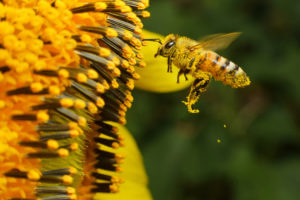While bee stings are no picnic, pollination from bees performs a vital role for a variety of plant life. In fact, a third of the food we consume relies on bees. Bees transport pollen from flower to flower, allowing them to become fertilized so that they can produce fruit and seeds. In recent years, bee populations have dropped off dramatically. While we are not exactly sure of the reason for this decline, we do know of several ways in which homeowners can increase bee populations on their property.

Bees gravitate toward flowers that are native to their area. Collections of varied wildflowers can help ‘trick’ bees into thinking that they are in the wild. Bees are also attracted to yellow, white, blue, and purple flowers.
Flowers that have only one row of petals make it easier for bees to reach a larger amount of pollen and are therefore ideal for maximum pollination. It also helps if the flowers in your yard have staggered bloom cycles, which will provide a steady supply throughout the season.
Bees prefer a natural, rustic environment. Setting aside a specific area of your yard and filling it with wildflowers and tall grass will make bees feel right at home. Your plants, local farmers, and the bees themselves will all benefit from your hospitality.






